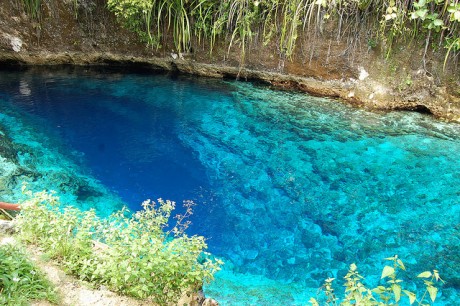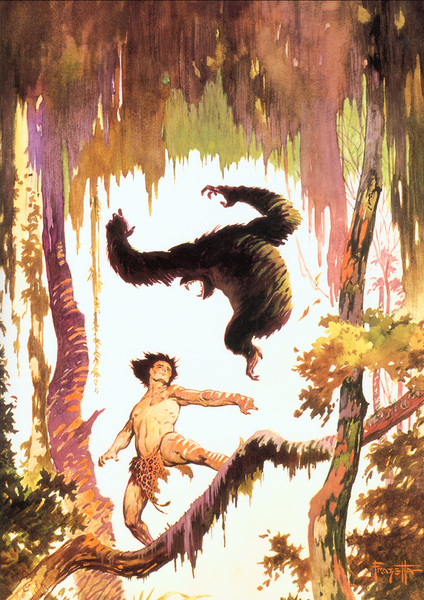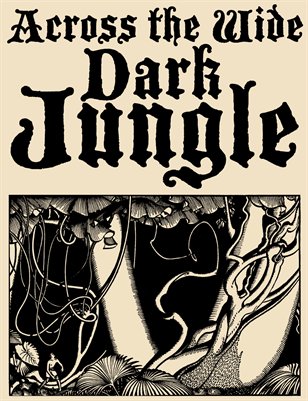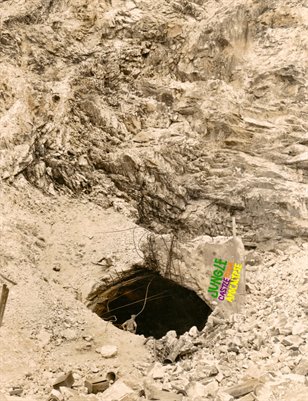A great moment in “fire in the jungle” history
June 22, 2011
I’m getting a haircut tomorrow to reshape my mullet. Since my last one a few months ago, the party in back has gotten pretty wild and the business in front has gone out of business. In honor of this, here are three mainstream jungle movies from the 80s.
The Mosquito Coast (1986). Directed by Peter Weir. Nice Belize jungle footage. I distinctly remember when my family rented this movie about 20 years ago and we all declared it perhaps the worst movie we had ever seen. I think I would like it better now. The ice quest is a cool idea. Bonus points for sweaty Helen Mirren.
Lord of the Flies (1990, filmed in 1988). Directed by Harry Hook. Great Hawaiian jungle footage. I remember feeling like such a rebel when watching this with cousins at my grandparents’ house, maybe 20 years ago. I was recently thinking about watching the 1963 b&w version directed by Peter Brook, but the trailer creeped me out.
Predator (1987). Directed by John McTiernan and filmed in lush Mexican rainforest. A classic that endures the test of time and stands out when compared to other macho/action/gun movies from this era. I envisioned the crater spawn monster as a cross between The Predator and The Cookie Monster. Check out this video about the gatling gun “Old Painless” used in the movie.
Images of The Jungle
June 16, 2011
I wish these could have been included in the Fire in the Jungle Supplement:

The Pool of Dreams. Some say it is a gate to another world. (In real life: The Enchanted River in Mindanao, Philippines.)
Blood Beak Jade Slime Rust Rhino Crater Spawn
June 15, 2011
Blood Beak
This huge bird loves the color red. Its beak is the size of a small canoe. It doesn’t eat meat or drink blood, but kills indiscriminately to bring bloody bodies to its macabre nest.
Jade Slime
This slime’s texture and colors give it the appearance of wet jade. It ambushes its prey and eats through everything except stone and hair within a minute. After eating through armor or clothing, it will eat through any non-hairy flesh on its victim within a minute. Jade Slime is immune to most attacks but is harmed by fire and killed instantly when touched by honey.
Rust Rhino
Large beasts with a hide of iron. The hide can be harvested and fashioned into makeshift armor (AC 3), but its rusted state causes it to deteriorate quickly. Deals 2x damage when charging.
Crater Spawn
Vile, mutant, emaciated apes born of the toxic crater pools in Scarred jungle regions. They are solitary and wander the Scarred jungles at night in search of prey. Eventually they get into the ant tunnels, from which they terrorize the entire jungle. Their eyes have evolved into large white globes protruding from the tops of their heads, giving them infravision and superb vision in darkness.
Is the Jungle Neutral?
June 14, 2011
The Jungle Is Neutral by F. Spencer Chapman, first published in 1948. The journal of a British officer conducting guerrilla operations in Malaya against the Japanese occupation. This work is often cited as a classic of jungle guerrilla warfare and survival.
Check out the wonderful journals and photos by Keong as he retraces part of Chapman’s path through the jungle. Keong’s site, My Rainforest Adventures, is a great collection of journals, photos, and tips by and for a modern-day jungle trekker. Lots of ways to start a fire in the jungle. Especially cool is the fire piston, a precursor to the diesel engine.
The myth of the jungle is that it is a wicked, inhospitable place. What does “the jungle is neutral” mean? It means the jungle does not care and is not a factor in determining if you live or die in the jungle. You are the deciding factor. Keep your head and your senses and your feet and the jungle will help you. Lose them and the jungle swallows you.
Bolo Men/Women are the daring heroes of the jungle clans. The most famous is Ceptaar. You too can play a Bolo Man!
The Bolo Man character class is a lot like the standard thief class, but with a few differences that emphasize it’s role as a “jungle specialist” instead of an actual “thief”:
- Always carries a Bolo, but may have other weapons too. (check out some sweet Bolo variations here)
- Cannot use metal armor, but can use shields made of animal hide or bark or other jungle resources.
- Instead of the Pickpocket skill, a Bolo Man has a Vine Swinging skill.
- Instead of the Open Locks skill, a Bolo Man has a Beast Riding skill.
- Uses an additional “reinterpretation” of thief skills.
For example, here are the skill percentages of a Level 1 Bolo Man:
- Beast Riding: 15%
- Vine Swing: 20%
- Remove Trap: 10%
- Move Silently: 20%
- Climb Wall/Tree: 87%
- Hide in Shadows: 10%
- Hear Noise: 33%
Standard thief skills often involve dangerous tasks that, upon failure, can seriously mess up the thief or get them into trouble. For this reason a thief player may sometimes be discouraged from using thief skills, especially at low levels. The Bolo Man reinterpretation of thief skills makes them less risky and encourages their usage. Here is the key:
The thief skill percentages don’t measure the chance of successful action, but instead measure the chance of the thief properly assessing the situation/obstacle in relation to his own capabilities.
For example, consider a Bolo Man examining a tree to climb. A successful climb roll means he determined that he is sufficiently skilled in this situation, so he climbs. A failed climb roll means he decided that he is not skilled enough to make this particular climb, so he doesn’t even try. No risk of falling.
In essence, the action isn’t performed until after a successful skill roll has been made. If the skill roll is not successful but the player insists that the PC attempt the action anyway, the judge can treat it the same as if a non-thief/Bolo Man were attempting the action.
This reinterpretation of thief skills is best used in conjunction with the possibility of a “fumble” to allow for an occasional dangerous failure. A fumble would indicate the Bolo Man attempted something he thought he could do, but either misjudged or fell victim to an unforeseen circumstance. For example: an unseen twig foiled an attempt to move silently, a loose section of wall caused him to fall, a trap had a devious fail-safe mechanism, etc. Fumble occurs on any double roll (00, 11, 22, 33, 44, 55, 66, 77, 88, 99), but only if the skill roll failed.
Journalist Kit Sharp came tantalizingly close to discovering a lost city on her previous expedition. She wasted no time in forming a new expedition and approaching the rumored lost city from the north, bypassing the swamps and desert that had blocked her from the south.
A mountain river valley was found that climbed to a high altitude swamp. And there hid the Lost City. Kit approached in a peaceful manner and was accepted as a guest of the city. They spoke ancient Greek.
Kit learned that a tyrant warrior-king ruled the city, but she had no problems the first month she lived there. It was a most pleasant life, but finally decided to leave. The tyrant refused her departure and imprisoned her.
Later, she learned of a young noble that aspired to overthrow the king. He offered to help Kit escape during an upcoming rebellion. Perhaps the king learned of this plan, because he soon ordered Kit to be thrown into the sacred pool to be devoured by a mosasaurus, a gigantic aquatic dinosaur which had miraculously survived the eons in this lost city.
Desperate, Kit attempted another escape and was successful. Upon her return to Europe, her story seemed too fantastical to be true, and it didn’t sell well. She scraped up a small expedition in hopes of completing her exploration of the White Nile, but a herd of stampeding elephants and an ambush of natives cut it short.
Kit now had very little money available to continue exploration. Then more bad news: Leski was rumored to have died during his latest expedition. Now she was the only remaining member of the Cairo Confidential. What about Leski’s treasure from King Solomon’s Mines? He had told her about the remaining riches that he had cached in a secret location. She had just enough money available to fund a small expedition to retrieve it.
But it wouldn’t be easy. Leski had befriended several tribes in the area near the Mines, but that wouldn’t help Kit. She must befriend them to gain passage to the Mines. Not only that, but because she couldn’t afford enough rations to last the entire journey, she needed the natives to feed her too.
Fortunately, the journey to the treasure cache and back went off without a hitch and now Kit was swimming in money to fund more exploration.
All that was left to explore in the Nile basin was the region west of The Sudd swamps. It would be quite a challenge, because the swamp and desert terrain in the area made foot expeditions the only option. Kit organized a massive expedition of footmen and partially explored the area before being wiped out by a thunderstorm in the desert and flash flood.
Another very large foot expedition was formed. A variety of hardships were endured: baboon attack, spoiled rations, sick musketeers, flooding, food-stealing chimps, sunstroke. Finally, the final hectare of the Nile basin was mapped: a lonely region of desert not far from Khartoum itself!
As it turns out, the actual “source of the Nile” was in the mountains south of Lake Kentucky, discovered nearly a decade and a half prior. Just over the ridge from where Dr. Roger Smalley had mapped the Rufiji River so long ago. (In fact, not too far from the actual source of the Nile and Lake Victoria!)
…
Well, that does it for the Cairo Confidential. I suppose I could keep playing out this campaign until Kit dies, but I’ll let her retire in peace. Besides, even though she’s still very good looking as she approaches 50 years of age, she’s just not quite as smokin’ as she used to be.
Moon Lake! Sea of Desert! Doc Missing!
June 8, 2011
Botanist Leski Osmonov set out to explore the entirety of the lake he discovered previously. He was successful, but not before his expedition was wiped out by natives and he explored alone for much of the way. He named it Moon Lake for its crescent shape. Still to be explored are the lands north of the jungle/swamp on the lake’s north east edge. Next, Leski followed rumors of a Lost Civilization northwest of King Solomon’s Mines, but the rumors proved false. On his way back, he visited his cache of treasure near the Mines and took out as much as he could carry. Vast riches still remain there.
Journalist Kit Sharp successfully completed her exploration of the eastern basin of the Nile. All that remains now is to explore whatever lies west of The Sudd. She heard rumors of a Lost Civilization to the west of Lake Kentucky, but her way was blocked by swamp and a sea of desert. Then tsetse flies sickened her entire expedition, killing several men and horses, and delaying her for three months. Next, she picked a fight with a tribe and lost all her men in the battle. She stumbled back to port and feverishly wrote up the story for publication in Europe.
Dr. Roger Smalley had planned to complete his exploration of the Congo basin. Nobody has heard from him and he is presumed dead.
I Love Trash
June 7, 2011
Too Late The Hero (Robert Aldrich, 1970). If only they had cut at least 30 minutes from this flick, mostly from the boring first half, this could have been a classic WW2 movie. The Philippines jungle crawl in the second half is good stuff. Worth watching to see Boracay before it became overrun with tourists and high-rise hotels.
Code Name: Wild Geese (Antonio Margheriti, 1984). IMDB indicates Hong Kong and the Philippines as filming locations, so I’ll assume the jungle scenes were done in the Philippines. They are only okay, but the main reason to watch this flick is the final battle with Lee Van Cleef and Klaus Kinski. Brings a whole new meaning to the phrase “fire in the jungle”.
Strike Commando (1987). Directed by Bruno Mattei in the Philippines. When it comes to low-grade Vietnam War/Cold War movies, it’s hard to get more low-grade than this. Therefore, we can laugh as we watch it and appreciate its existence as a cultural artifact. Namedropping this flick can earn you serious cred with “bad movie buff” folks. Regarding the jungle stuff, some good stuff and some “not jungle” coconut plantation stuff.
Behind Enemy Lines (1986). Directed by Gideon Amir in the Philippines. Not to be confused with several other movies of the same name, this one is also known as P.O.W. The Escape or Attack Force ‘Nam and stars David Carradine. He plays a serious, dedicated colonel and doesn’t crack a smile the entire time, but I got some good laughs watching this flick. Maybe the Tanduay 1854 had something to do with it. Jungle footage is decent, though much of it looks like a coconut plantation to me. Bonus points for the punji rack trap swinging down from the trees.
Last we heard from the Cairo Confidential, the surviving explorers had all gathered in the shadows of the Giza pyramids to plan their next expeditions. Here are summaries of the results of these expeditions:
Journalist Kit Sharp completed two important objectives. First, she completely mapped the Blue Nile. Next, she mapped the boundaries of Lake Kentucky. She also discovered that The Sudd swamps extended further east than previously thought, complicating exploration of the White Nile. Other significant discoveries were the names of three tribes: the Hatsa, the Bahutu, and the Bushmen. Kit even sign pact with a chief awarding all his tribal lands to America.
Dr. Roger Smalley set out to complete exploration of the Congo basin. He established the boundaries of the basin but was unable to map the entire river before his expedition was wiped out in an ambush of natives. Dr. Smalley survived. He discovered the edges of another river basin that extends far to the south, perhaps connecting to the Orange River or the Zambezi River. The doctor cured the diseases of several tribes, but his most important discovery was a bizarre tribe that claims the be descendants of King Arthur. It seems their language has no word for “sad”, so perhaps Camelot lives, deep in the interior of Africa! The publication of this discovery caused quite a stir in Europe and now Dr. Smalley is obligated to take witnesses to the tribe to establish the veracity of the tribe.
Botanist Leski Osmonov discovered a massive lake not far inland from the mouth of the Ogoue River. He followed the south coast of the lake in canoes and then cached the watercrafts to follow rumors of a great discovery not far to the east. A great discovery indeed…Leski found King Solomon’s Mines. A witchy guide helped him gain access to the treasure chamber, but then betrayed him and trapped Leski and much of his expedition inside. Fortunately, a secret passage was found descending into a labyrinth of mine shafts and eventually they found their way back to the surface. So much treasure was retrieved that only half of it could be carried by the bearers back to civilization. The other half was cached outside of the mine, waiting for Leski’s return.
Missionary Jose Miguel Harpua has not been heard from. He is rumored to have died when his canoe was pulled into a whirlpool on the Niger River.
What Makes Them Special
June 2, 2011
Wrapping up the series of posts about rules supplements for Source of the Nile. So far, three of the four Special Discoveries have been given attention:
Here is the last Special Discovery to be detailed: Native Kingdom. The legend of Prester John or stories by Edgar Rice Burroughs seem like obvious inspirations for creating a Native Kingdom rules supplement, but I decided to take inspiration from something that I had been researching lately: the Tasaday controversy.
The general idea of this rules supplement is that these natives have some unique or unbelievable qualities about them. This raises public interest upon publication of their discovery, but also fuels speculation of fraud…that their existence was fabricated to bring the explorer fortune and fame.
When the Native Kingdom is found, treat it as a Large tribe. When the explorer becomes friendly with the tribe, roll to determine What Makes Them Special and a Language Peculiarity.
What Makes Them Special d6
1. All are descendent of King Arthur
2. Worship the writings of Karl Marx
3. Speech contains random tongue clicks and “rub-a-dub-a-dub”s
4. Survive on only 7 minutes of “labor” each day, making them the most “affluent” people ever
5. Wear t-shirts that say “Boston Red Sox 1986 World Series Champs”
6. Possess thousands of glass Coca-Cola bottles
Language Peculiarity d6
1. Their language has no word for “day”
2. Their language has no word for “night”
3. Their language has no word for “birth”
4. Their language has no word for “death”
5. Their language has no word for “happy”
6. Their language has no word for “sad”
After the explorer publishes the existence of this tribe, he can escort witnesses to see the tribe. Each witness counts as an expedition member but doesn’t do anything useful. The explorer can take as many witnesses as desired, but remember: they eat rations like any other expedition member. Also, the explorer loses 1 VP for each witness that dies during an expedition. If a witness returns safely to Europe after having met the tribe, the explorer earns $500.
There is another drawback. If the explorer ever completes an expedition without having visited the tribe, he is labeled a fraud, sent into exile, and must be retired from play.





















